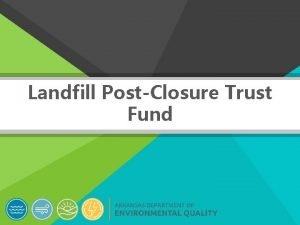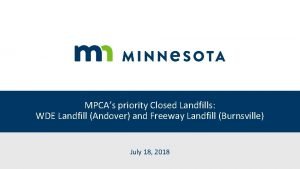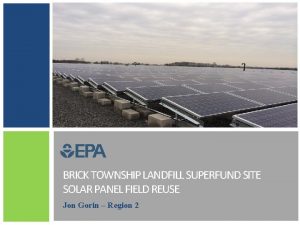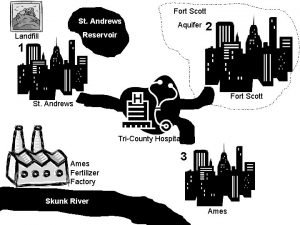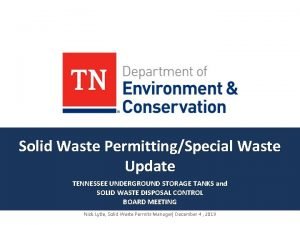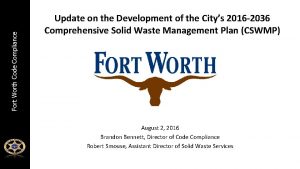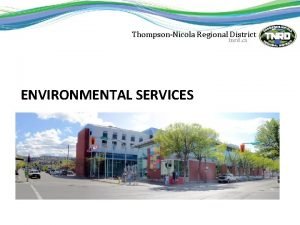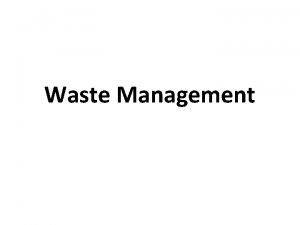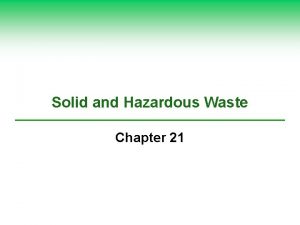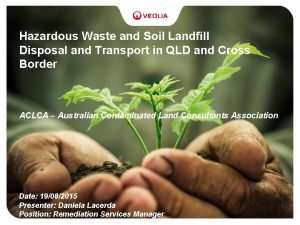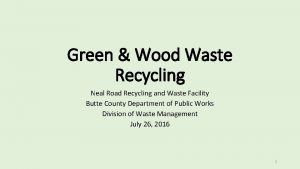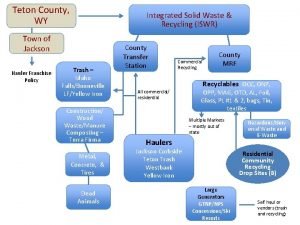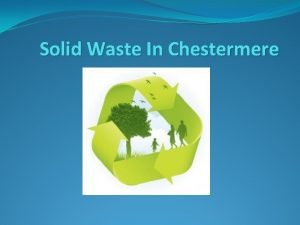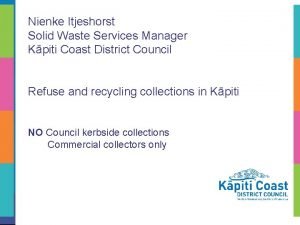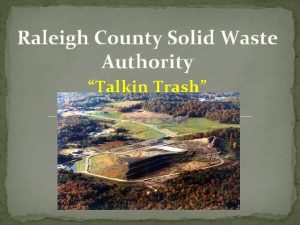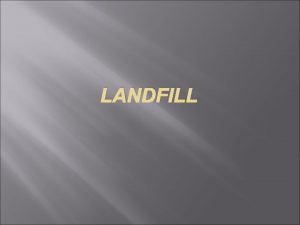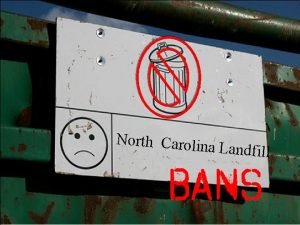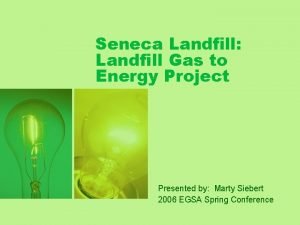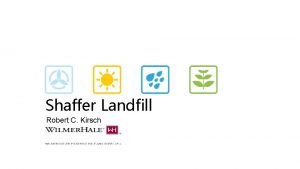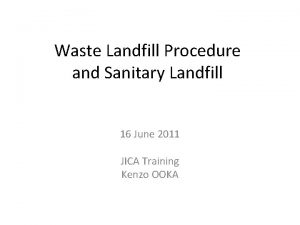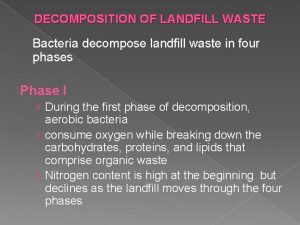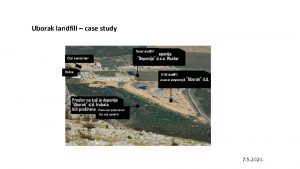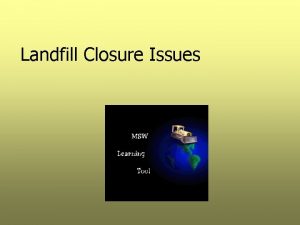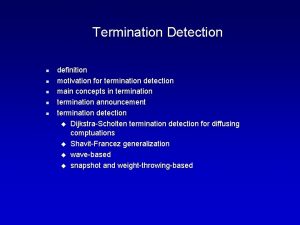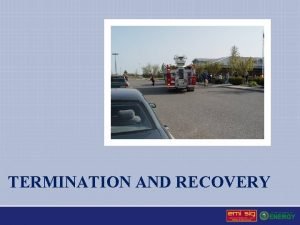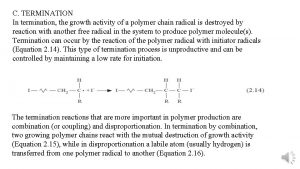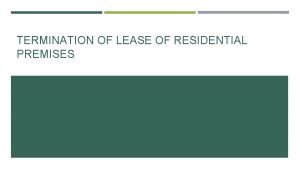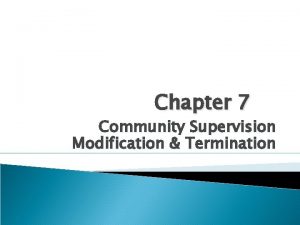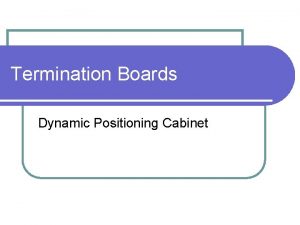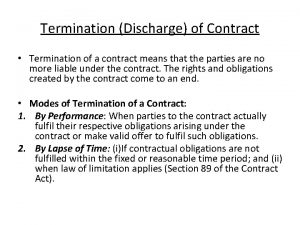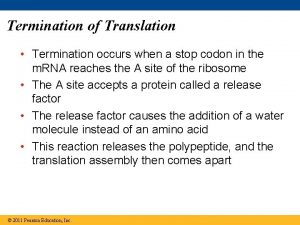Regional Approaches for Termination of Landfill Post Closure






















- Slides: 22

Regional Approaches for Termination of Landfill Post Closure Care Jeffrey Murray, PE, BCEE, Waste Sector Landfill Practice Leader | HDR Dr. Bryan Staley, PE, President and CEO | EREF Wednesday, August 28, 2019 3: 00 PM – 3: 30 PM

SWANA’s New Technical Policy T-9. 3 § “T-9. 3 Termination of MSW Landfill Post Closure Care Requirements” o Developed in Collaboration with NWRA o Reviewed and Approved by Technical Divisions and 70 Member International Board § § § Why now? Where are we? Where can we go? What are we recommending? What else can we do?

Why Now? § RCRA – No Guidance for Termination of PCC § 30 Years PCC Period Are Ending § No Common Defined Approaches o Don’t Need 50 Different Solutions § Support Performance Based Approach o Data, Data

Current US Landfill Post Closure Care Termination Requirements Per Subtitle D with Modifications Functional Stability Organic Stability ALASKA HAWAII

Where Are We? § Little National Dialogue § Slow to Change § Hz. W Guidance Published § What happens after PCC? § Long-term Care § Custodial Care § Undefined

Where Are We? § Organic Stability o Kansas – Trend Analysis o Wisconsin – Stability Plans § Functional Stability o Florida – Methodology o Washington – Risk Analysis o Ohio – New Draft Guidance June 2019 o Virginia – Risk Based Evaluation, Uniform Environmental Covenants Act (UECA)

Where Can We Go? § EPA Guidance? § Regional Approaches o How do you define stability § Prescribed Methodology o Percent Reductions Achieved o Adequate Protection of HHE § Scientific Performance Based Approach

Policy Statement Support use of Performance-based evaluations for PCC termination § Identifies Criteria for demonstrating protection of HHE in absence of active controls § State Programs Should Incorporate the Following: 1. The regulatory PCC period should have a finite term with the length determined on a site-specific basis; 2. The conduct of a performance-based evaluation of the closed MSWLF that relies on the collection and analysis of site-specific data over a defined period can be an effective means of establishing the requisite length of the PCC period on a scientific basis; and 3. The identification and weighting of performance-based criteria should be established along with the technical evaluation approach with input and consensus from appropriate stakeholders.

Ohio EPA Draft Guidance Provides methodology for a systematic evaluation and decision process based on site-specific data and a defined end use of the property https: //epa. ohio. gov/Portals/34/document/general/end of post closure draft. docx § Allows for Step Down of PCC Activity to Evaluate Consequences, 5 Year Check-in § Requires Evaluation of 10 Years of Data Trends o Leachate Quality/Quantity/Rate of Generation o GW Quality and any Assessment Monitoring or Corrective Measures o LFG Generation and Migration trends, locations of structures within 1000’, status of air permits o Cap Integrity and summary of any maintenance performed o PCC Compliance History § Ongoing Obligations after PCC Termination o Authorization to Disturb o Prevention Pollution of Surface Waters – minor maintenance of final cover, surface water diversion o LFG Migration Control o Adhere to Institutional Controls

Recommendations § Groundwater o Demonstrate at or below regulatory levels o No impact after termination of active controls o Indicator parameters § Leachate o Quantity and quality stable o No unacceptable risk to POE o Data • BOD/COD • Ammonia • p. H

Recommendations § Landfill Gas o Generation decreasing o Does not pose risk to HHE at POE o Migration concern o Quality § Stability and Cover Integrity o o Controlling LFG emissions Reduced leachate Little to no settlement Long-term stormwater management

What Else Can We Do? § Work with State Programs and Encourage Regional Approaches § Set the same bar § Instill More Confidence in Mitigation of Risks § Smoother Transition to Long-Term Management and Re-use

Basis for PCC – A Recap § Protection of human health and the environment (HHE) by reducing potential threats to acceptable levels at the relevant point of exposure (POE) § Typically the closest property boundary location where human or ecological receptor could be exposed and receive a dose via potential migration pathway as defined under RCRA (US EPA, 1993) § Authority rests with state agencies to determine sufficient PCC time period, but no guidelines exist that allow agency to determine this § The general assumption is a prescriptive 30 -year term for PCC, but the regulation is actually performance based (40 CFR§ 258. 61 – RCRA Subtitle D)

Approaches for Performance Based PCC § Organic Stabilization § demonstration of a relatively inert waste mass § Functional Stability § considers long-term emissions in context of threat potential WITHOUT active controls § measured at a point between landfill and POE • Goal in either case is going from active postclosure care to a point of custodial or ‘de minimus’ care where HHE is protected

Active Post-Closure Care GP-2 Homes GP-1 MW 1 LANDFILL Gas Flare Station SUMP-3 SUMP-2 Surface Water Discharge GP-3 SUMP-1 Leachate Storage Tank MW 2 Source: Morris & Barlaz, 2017

Custodial or ‘de minimus’ Care Homes Passive Gas Biofilter Constructed Wetland System LANDFILL SUMP-3 Property Boundary Surface Water Discharge SUMP-2 SUMP-1 Source: Morris & Barlaz, 2017 Farmers’ Windmills

Organic Stabilization § Requires near-complete degradation of waste mass (i. e. inert solids in the waste mass) § May offer maximum protection of HHE but also may be ‘overkill’ § Approaches suggested typically do not allow for a ‘step down’ in PCC activities over time § Can imply very long-term (30+ years) or near perpetual care under a regulated program (Scharff et al. , 2011) § Little consideration of cost; likely most expensive option

Demonstrating Organic Stability Chemical Oxygen Demand § Extent of biodegradation § Remaining LFG production § Remaining settlement § Leaching potential § Assessment of future leachate quality COD Concentration (mg/L) § Typically two characteristics of concern for waste 60000 50000 mass: 53800 40000 30000 20000 6550 10000 825 0 0 § Interpretation of how to demonstrate/implement varies 10 20 Bioreactor § Implies characterization of buried solids that is representative of the entire waste mass § No guidance on what testing is appropriate and target levels; wide range of tests could be used (Wagland et al. , 2009) § Trends in LFG, settlement, leachate generation may provide suitable surrogates 30 L/S Leaching 40 50 60

Post-Closure Methane Collection Data Case Study on Solids Analysis BMP of Excavated Samples pure cellulose 414. 8; pure hemicellulose 424. 2 • normalizing to VS is critical (pure cellulose 414. 8; pure HC 424. 2) • Solid analysis shows high variability despite significant downtrend in CH 4 generation Source: Morris and Barlaz, 2017

Functional Stability § Relies on conservative impact assessments to define PCC monitoring and management (Morris and Barlaz, 2011) § Central elements include: § Leachate and LFG management § Groundwater monitoring § Cover maintenance § Eliminates active controls, replacing them with passive measures, once minimal impact target levels have been achieved for each element § Allows for remaining elements of concern to receive focused attention, with the receiving environment and property end-use being important inputs to the evaluation § Optimizes management strategies; minimizes costs

Demonstrating Functional Stability § LFG production is stable or decreasing § < 10% of peak LFG generation § Settlement is essentially complete § <5% annually relative to cumul. total post-closure volume reduction § Leachate quality is stable or improving § satisfy criteria for ‘gateway indicators’ (e. g. BOD/COD < 0. 1) then meet WQS (preferably at source or, failing that, at POC) § Emissions of leachate/LFG will not unacceptably impact HHE via potential pathways to air, groundwater, surface water or vadose zone § Critical aspect of the approach is a confirmation monitoring program, which is designed to track when active controls can be stopped and a full transition from PCC to custodial care can occur Source: S. T. O’Donnell et al. , 2018 Analysis of LFG Collection Using Functional Stability Approach • Plot measured data • Run LANDGEM model for LFG generation • Run LANDGEM model for collected LFG • Align with data so model results match observations, which provides a projection of future LFG collected • Determine when stability target for LFG is achieved

Conclusions § Performance-based strategies tend to be more consistent and are backed by data vs. organics stability strategies which primarily aim to preemptively divert organics away from landfills § Use of performance-based post-closure criteria appears justified and is taking hold based on: § Peer-reviewed science (numerous publications support approach) § Implementation by regulatory agencies (now in 8 states) § State agencies should work collaboratively for consistency § Endorsement by trade associations (SWANA, NWRA) § But chapters should work with state agencies to help develop guidance § Data collection must start early § Ideally when landfill is still accepting waste § Performance-based methodology is more complicated/detailed § Additional work is needed to streamline and simplify how the Credit: www. watershedgeo. com
 Rolling knolls landfill
Rolling knolls landfill Baxter landfill
Baxter landfill Wde landfill
Wde landfill Sanitary landfill advantages and disadvantages
Sanitary landfill advantages and disadvantages Landfill
Landfill Brick township landfill
Brick township landfill Fort scott landfill
Fort scott landfill Negus landfill
Negus landfill Lawrenceburg tn landfill
Lawrenceburg tn landfill Code compliance drop off ft worth
Code compliance drop off ft worth Pasco sanitary landfill
Pasco sanitary landfill Tnrd.ca
Tnrd.ca Liquid wastes examples
Liquid wastes examples Sanitary landfill
Sanitary landfill Wattle glen landfill
Wattle glen landfill Neal road landfill
Neal road landfill Teton county trash transfer station
Teton county trash transfer station Chestermere recycling depot
Chestermere recycling depot Itjeshorst
Itjeshorst Landfill beckley wv
Landfill beckley wv Sanitary landfill
Sanitary landfill Garbage in garbage out diagram
Garbage in garbage out diagram Reduce definition environment
Reduce definition environment

